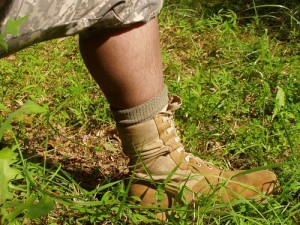 I learned some interesting facts about a very manly friend of mine that shared some of his experiences while in the Marine Corp. He was stationed for a time in Camp Lejeune, North Carolina and spent plenty of time performing field maneuvers while there. A Gunnery Sargent gave him and his squad some surprising advice “get yourself some panty hose to wear”.
I learned some interesting facts about a very manly friend of mine that shared some of his experiences while in the Marine Corp. He was stationed for a time in Camp Lejeune, North Carolina and spent plenty of time performing field maneuvers while there. A Gunnery Sargent gave him and his squad some surprising advice “get yourself some panty hose to wear”.
On previous exercises it was not uncommon to find literally a couple of hundred ticks and chigger bites on each soldiers body, mostly from the waist down. So, my friend and the members of his squad decided to follow the Gunnery Sergent’s advice and bought panty hose in a color they would affectionately call “desert brown”. Competing squads scoffed at them as they set out on maneuvers, knowing that his squad was wearing hosiery under their fatigues.
Miraculously, at the end of each day as they inspected their bodies for these prevalent pests, NONE were found from the waist down! This fine-mesh undergarment had blocked all ticks and chiggers! Not only did the hosiery prevent bites, it also reduced “hot spots” and blisters on their feet.
Many folks may chuckle at the thought of Marines out in the field wearing hosiery , but if you consider the motto “adapt and overcome”, this great “out of the box” thinking achieved superior results. So, you’ve got to ask yourself, on your next foray into tick and chigger infested country, are you man enough to wear panty hose?



Huh, never heard of that for bug deterrent, but there were guys I knew of that would wear them to cut down on chafing and blisters.
In basic training we were given these to prevent blisters in our new boots. I wore them my entire military career. They proved to be effective for many things, bug bites,, chaffing in the ‘unmentionable’ areas, sweat, insulator for cold guard duty and tactical missions, and it kept my skin from turning black in my MOPP gear. Knee highs with the toes cut out were great for covering your arms.
This is actually fairly true.. I treeplant in NW Ontario. And Panty hose are what myself and other planters use to repel ticks.. ask any tree planter why they were panty hose. they’ll tell you.
Another very ‘manly’ group – Australian lifesavers – apparently wear panty hose as protection against the extremely venomous box jellyfish.
Do they make them for dogs?
We did this fourty years ago..same reason.. bugs no get through the panty hose…you could always tell when there was a new set of guys coming in for training..there was a run on the hosery department. Glad to see they have not fallen out of fashion.
Tsgt USAF Ret,
They should make threm in cammo and maybe it’d seem more manly.
They are also good for cold weather. My ex and his co-workers used to wear them when they had to work outside during the Chicago winters.
Ever wonder how women can still wear dresses in the winter? It’s our pantyhose.
They do make them in Camo.
There was a product called Rhinoskin, specially made for preventing ticks and chiggers bites. I purchased a set in Virginia a couple of years ago and as I am a tick and chigger magnet, wore them on tracking classes in Oklahoma, home of the most voracious ticks and chiggers this side of the Missisippi. Both the top and bottom camouflage parts worked magnificently and for the first time in years did not go home to Arizona scratching like a hound dog in the Ozarks! Great product and well worth the price I paid for the set.
I was a Navy Corpsman stationed with the Marines. Pantyhose were commonly wore(and they do work). Many times when we were going out to the field a Marine would stop by and ask me that if they were hurt if I would remove their pantyhose before I’d medevac them so that if their wife had to identify them they wouldn’t be found with pantyhose on.
6/21/2018
I found this true I tried the pantyhose and found that it does work. Hard to put on at first and my wife gave me a pair and I worked out in tall grass for 5 hours and to my surprise only 1 tick on my pants and none on my legs. The more thicker the better. Sorry but better than getting lymes disease
Got to give it a try
John